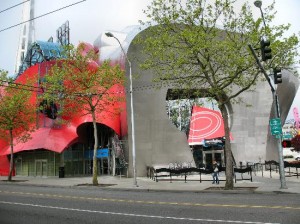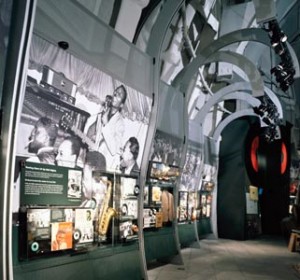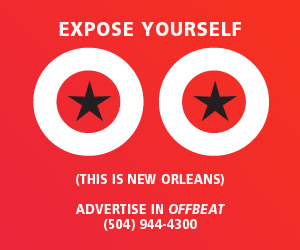Of course I know the city of New Orleans is in a deep financial hole right now, thanks to a previous administration that spent money (that we didn’t have) like water. But I guess I’m the kind of person who always wants to push the envelope. If we don’t have a vision of what we want the city to be, then we’ll never be it. If you don’t have a goal that you set to achieve, then you’ll never achieve it. Without going into one of my famous rants, this has been New Orleans’ problem as long as I’ve been active in the music scene. No one can quite decide what we need to do to capitalize on our music and culture. It’s sort of been a side note to the city’s reputation as “party city,” thus the line used for the past few years in marketing New Orleans: “Come Out and Play.”
The perception of New Orleans as a place to get drunk and party is one that’s been carefully cultivated by the hospitality industry and city marketers for at least half a century. The idea is to fill hotel rooms. The creation of this image has worked, but in a lot of ways it’s backfired because it puts us into a category of places you might want to visit, but you wouldn’t want to live in. Surely many of you can understand that visitors to the city might see only Bourbon Street—because they’ve been told that’s the “thing to do” when they go to New Orleans.
Okay fine. But there’s so much more. The challenge is to create another image for New Orleans that focuses on our culture. Partying and Bourbon Street and Mardi Gras and Creole cooking are, of course, integral to New Orleans’ appeal, but what about our music, our artists, our writers, our architecture, our unique traditions?
If you read my blog and the Weekly Beat, you know I’ve been out of town for the past week. We took an Alaska cruise to celebrate my mother’s upcoming 80th birthday. It’s always interesting and instructive for me to go to other cities that do things differently. I made a point to visit the Experience Music Project/Science Fiction Museum (EMP/SFM), the great museum designed by architect Frank Gehry and financed by Microsoft founder Paul Allen, who invested a reported $264-million in building the project. According to the EMP’s website:
Since EMP opened in 2000 and SFM in 2004, EMP|SFM has welcomed more than 4.5-million visitors. From its museum planning stages in 1998 through 2009, EMP|SFM has been a key economic driver among Seattle nonprofit arts and culture organizations, with combined EMP|SFM institutional expenditures and EMP|SFM audience-member spending resulting in $651-million dollars of local economic impact. EMP|SFM is housed in a 140,000 square foot Frank O. Gehry-designed building. This spectacular, prominently visible structure has the presence of a monumental sculpture set amid the backdrop of the Seattle Center.
EMP is dedicated to the exploration of creativity and innovation in popular music. By blending interpretative, interactive exhibitions with cutting-edge technology, EMP captures and reflects the essence of rock ‘n’ roll, its roots in jazz, soul, gospel, country and the blues, as well as rock’s influence on hip-hop, punk and other recent genres. Visitors can view rare artifacts and memorabilia and experience the creative process by listening to musicians tell their own stories. The Science Fiction Museum and Hall of Fame (SFM) is the world’s first museum devoted to the thought-provoking ideas and experiences of science fiction. SFM’s exhibitions promote awareness and appreciation of science fiction literature and media while encouraging visitors to envision new futures for humanity. In the Science Fiction Hall of Fame, the museum pays homage to the most respected of science fiction practitioners—writers, artists, publishers and filmmakers.
While I was there, there was an awesome traveling exhibit of costumes worn by The Supremes. The permanent collection has space devoted to the Seattle music scene (oh, we could definitely blow them away with the history of New Orleans and Louisiana music); a large exhibition devoted to Jimi Hendrix (a native son whom Paul Allen was into); a great collection of antique and innovations in guitars; interactive areas for telling stories, creating music and recording; a nice museum store; and of course, the very cool landmark Gehry building and an astounding centerpiece sculpture of instruments, mostly guitars. (By the way, I found it interesting that in Seattle every new construction must include at least 1% of the total project cost as public art).
It seems to me that we are really, really missing the boat by not having a New Orleans museum dedicated to music. Not just jazz, or Mardi Gras Indians, or R&B. We need an all-encompassing testament to the greatness of our music and how it’s influenced the world. Seattle? Please!
All we need is money and a building big enough to do the subject justice. There are a ton of vacant properties on Canal Street, which could be an ideal place for such a project. Putting such a museum together is going to be a challenging and time-consuming project that likely won’t be complete for years. But it’s time to start the development process: planning the project, acquiring the site, getting a buy-in from the music community and the hospitality industry (particularly the hospitality industry, since they have the purse strings) and finding a sponsor or sponsors’ money for a state-of-the-art “New Orleans Music Experience.” This concept needs to be in the sights of our current mayor and his team. It’s the visionary thing to do.






